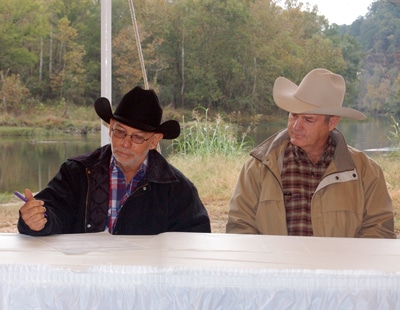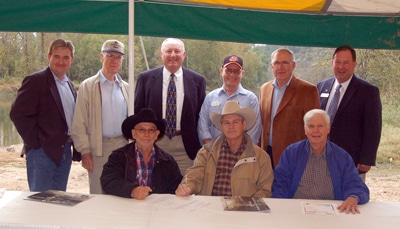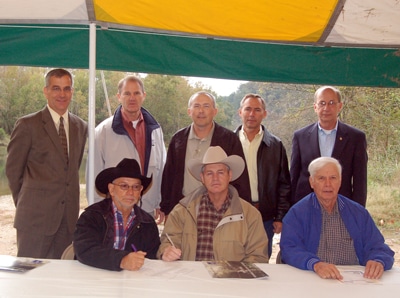Conservation Reserve Enhancement Program – First Contract
An event marking the signing of the very first Oklahoma contract for the Conservation Reserve Enhancement Program (CREP) was held at Riverside Park along the Illinois River in Tahlequah on Oct. 26. The contract marks the beginning of a $20.6 million cooperative conservation partnership agreement between U.S. Department of Agriculture and Oklahoma that will create up to 9,000 acres (or 370 miles) of riparian buffers and filter strips. The conservation plantings will reduce the flow of nutrients, sediment and other pollutants in the Spavinaw Lake and Illinois River/Lake Tenkiller watersheds (Oklahoma CREP). Jerry Hammons of Tahlequah is the first landowner to sign a contract for the new program.

Land owners participating in the program will receive annual rental payments, financial and technical assistance and other incentives for voluntarily enrolling land into contracts. FSA will administer Oklahoma CREP, with support from state CREP partners. Eligible landowners will receive up to 90 percent of the cost of practice installation in addition to their annual rental payments and their signing incentive payment.
In Hammons’ contract, will remove 14 acres of his land from agricultural production, in a 300-foot wide strip bordering the Illinois River to develop riparian (streamside) buffers and filter strips of vegetation. The conservation plantings will reduce the flow of nutrients, sediment and other pollutants in the Illinois River/Lake Tenkiller watershed. In return, Hammons will receive $63 per acre per year plus a $6 per acre per year maintenance payment for the 15-year life of the contract. He also receives a one-time $100 per acre signup incentive at the beginning of the contract. The total payment is $15,990 to take out of cattle production a strip of land 300 feet wide and just under four miles long. And that first piece is a small portion of the total 370 miles the sponsors would like to enroll in the program.
“I have an interest in keeping the Illinois River water clean,” Hammons said. “This way, I can accomplish that and receive some compensation for taking the land out of production too,” he said.

At the state Capitol in April, Oklahoma Governor Brad Henry and U.S. Deputy of Agriculture Secretary Chuck Conner signed the Oklahoma CREP agreement, paving the way for the program in Oklahoma. The Oklahoma Conservation Commission (OCC) is the state agency managing the Oklahoma CREP. USDA Farm Service Agency (FSA) will administer the federal portion of the funding. Key partners include the City of Tulsa’s Metropolitan Utility Authority, Oklahoma Scenic Rivers Commission, five local conservation districts, and USDA Natural Resources Conservation Service (NRCS).
“Spavinaw Lake is the primary water supply for our second largest city. The Illinois River is our most iconic scenic river,” said Miles Tolbert, state Sec. of Environment. “These waters both face serious challenges. With the creation of a CREP we are rising to that challenge,” Sec. Tolbert said.
“Farmers and ranchers are the original conservationists. They have to constantly conserve and enhance their land to keep it productive. They live on the land and are intimately tied to it,” said Terry Peach, state Sec. of Agriculture. “In this modern world of global trade however, it’s not always so easy for a farmer to make a living and still give back to the land what it needs. This CREP program will allow the farmers of these two watersheds to achieve both purposes and all the citizens of Oklahoma will reap the reward,” Peach said.

OCC, collaborating with local conservation districts, NRCS and FSA, will identify eligible producers with appropriate land for enrollment in the program. The state will provide payments to participants and pay a minimum of 20 percent of the overall costs of the Oklahoma CREP. The state will provide a minimum of 20 percent of the overall costs of the Oklahoma CREP. OCC will also provide staffing for the project and coordinate with other natural resource conservation programs at the local, state and federal levels. The state will provide $4.1 million in cash and in-kind services for Oklahoma CREP. USDA will provide 80 percent of the overall costs, making a total of $20.6 available for the program.
“The Conservation Commission and local conservation districts have been helping to implement conservation practices to protect water quality for years,” said Mike Thralls, executive director of the Oklahoma Conservation Commission. “Utilizing programs like CREP is the next logical step in implementing that water quality conservation,” Thralls said.
USDA will accept offers for contracts under this CREP on a first-come/first-served basis until the 9,000-acre goal is achieved or until Dec. 31, 2007, whichever comes first. More information about the program can be found in the Oklahoma CREP fact sheet posted online at http://www.fsa.usda.gov; click on Find FSA Fact Sheets.
